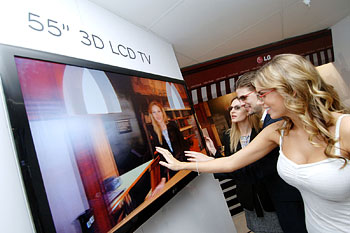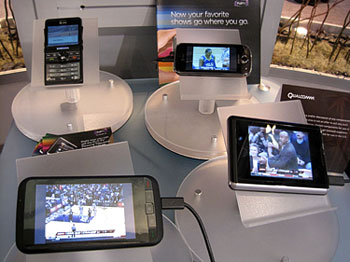CES: TV Goes 'Any ’Ware'

Among the 3DTVs at CES 2010 was this LG Electronics 55-inch LCD display.
LAS VEGAS
TV everywhere and anywhere, along with anyway, anyhow and delivered via almost any ’ware, permeated the 2010 International Consumer Electronics Show. Beyond the ballyhooed 3DTV demonstrations and IP-connected TVs, CES showcased the ingredients of a significant shift in the video industry, ranging from mobile TV to haptic interface products to e-readers, some of which have video capabilities.
At the same time, the growing presence of digital content producers—ranging from a well-funded offshoot of Barry Diller’s InterActive Corporation to the digital units of ABC/Disney, NBC Universal and Sony Pictures—provided evidence of the shifting TV landscape.
Moreover, with a larger-than-predicted crowd of an estimated 120,000, (about 6 percent more than 2009), there was an upbeat mood of a revived business atmosphere after the dim 2009 track record. The Consumer Electronics Association, which runs CES, predicted a modest 0.3 percent uptick in all CE sales for 2010, to just over $165 billion in wholesale value.
And as the Washington debate about a broadcast “spectrum grab” heats up, FCC Chairman Julius Genachowski was on hand at CES, acknowledging that, the “millions of Americans who get their video programming over-the-air” represent “an important reality that has to be taken into account in anything we do.”
MOBILE DTV’S ‘MOMENT’
Mobile DTV ranked high among the video hopefuls, with focus on both the Open Mobile Video Coalition-organized consumer field trial in the Washington-Baltimore area this spring and also the revived efforts of the re-christened FLO-TV (formerly MediaFlo), which is expanding its rollout in dozens of markets, bolstered by new Audiovox-branded receivers.
OMVC orchestrated a Mobile DTV pavilion/showcase where dozens of products, ranging from Samsung’s new “Moment” handset with built-in DTV receiver, to the Tivit, a WiFi dongle that receives mobile ATSC signals for portable devices. The Tivit is made by Korea’s Valups, which is partially funded by OMVC. LG unveiled a $250 mobile receiver (with DVD player) with a 7-inch screen.
Sprint, the third largest U.S. mobile phone operator, will be the wireless carrier partner for this spring’s DC-area field test and will distribute the Moment, which is built around the Samsung mobile DTV chip, the first single-chip solution for the ATSC mobile DTV standard. The handset uses a 3.5-inch OLED (Organic Light Emitting Diode) screen, one of the first times OLED technology is being used on a consumer handset.
Eight local area TV stations are committed to transmitting up to 20 channels of free and fee-based programming to hundreds of devices that will be deployed for the DC test.
Other products in the Mobile DTV “Tech Zone” exhibit included devices from iMovee, including the Mobidik, a wireless receiver that streams MDTV content to handsets such as iPhone, Blackberry and Nokia phones and netbooks through WiFi.
Roundbox showed its server for MDTV delivery, including the Roundbox Client software, a cross-platform solution that supports Internet-connected and broadcast only operations. The company says that 15 stations have installed the Server, which is priced at about $30,000 per site.
EXPWay featured its FastESG (Electronic Service Guide), which integrates live TV, VOD, application downloads and other content, and FastCollection, a solution to monitor which programs are most viewed and the viewer response to advertising, banners and interactivity.
Separately, FLO-TV, the Qualcomm-backed mobile video service, showed an expanded line of portable and in-vehicle devices, including one with a built-in DVD player from new partner, Audiovox, the electronics maker and distributor. Audiovox and Qualcomm, the chip-maker, are positioning FLO-TV, which is now available in about 100 U.S. markets, as “complementary” to the ATSC MDTV system.
SCREENS GALORE
For the first time in several years, TV set makers were not one-upping each other, or more precisely one- or two-inch upping each other, in screen sizes. Nonetheless, Panasonic showed off a 152-inch 4K high definition 3D plasma screen, which uses a new super-efficient quadruple luminous efficiency technology. No price or delivery timetables were offered.
Other major TV set makers concentrated on features to enhance picture quality and device capabilities. Toshiba unveiled ZX900 Series 55-inch and 65-inch receivers based on the “Cell broadband engine” microprocessor, which it has been developing with Sony and IBM since 2005. Cell includes Toshiba’s TriVector Conversion, which converts 2D content into 3D in real time. The “super-resolution” Cell TV offers Quad-HD or “2k-by-4k,” which has four times the resolution of typical 1080p sets, with maximum resolution of 3840x2160.
LG Electronics claimed this year’s bragging rights for thinnest screen: a 6.9 mm LED large screen monitor. The company also put wireless HDMI connectors on many of its TVs, providing a 30-meter range for in-home video delivery from a PC or media center device.
Sony, Samsung, Panasonic and the other majors focused on 3D and video improvement features. Among the standout comments during the series of pre-CES news conferences was the forecast from a top Samsung executive that the company expects to reach $400 billion in global revenues by 2020, up from $110 billion in 2009. The figure represents all of the company’s worldwide ventures, including its massive mobile phone business.

A plethora of devices for ATSC Mobile DTV could be found in the OMVC Tech Zone. 3D TV was omnipresent among the largest TV set makers. The major differentiator at this early stage is the shape and color of the viewing glasses, either active shutter or polarizing lenses. Skeptics cited factors that could impede 3D deployment, such as the cost of the glasses (up to $100 apiece) and problems if a viewer tilts his head or watches from a prone position or angle.
Chris Cookson, the technology president of Sony Pictures Entertainment, speaking on the Up Next conference program, predicted that within five years, technology will be available for 3D without special viewing glasses.
Of greater immediate concern for 3D appeal is the limited supply of 3D programming. Despite announcements from ESPN, Discovery Networks, Dreamworks and other content suppliers, the pipeline for 3D content is still limited, which will affect the demand for 3D sets, even if they cost only a few hundred dollars more than conventional HD receivers, as many experts predict.
For producers, the incremental price of producing in 3D is also an initial challenge. While some analysts predict that 3D production will cost only about 20 percent more than conventional formats, an ESPN executive said that the network’s first 3D sports programs will carry a 100 percent increment. ESPN plans to shoot simultaneously in 2D and 3D, thus fundamentally doubling its costs for those shows.
POINTING THE WAY
Haptic (touch-sensitive) and gesture-controlled navigation systems popped up throughout the show, suggesting that eventually the disappearance of the familiar remote control into the sofa cushions may become a non-issue.
Prime Sense, an Israeli chip designer that created the gesture-control system used for the Microsoft Project Natal videogames, privately demonstrated its system that can control devices at the wave of a hand or a fingertip. The system uses a set-top camera and infrared sensor to spot and identify control gestures.
Toshiba demonstrated prototype gesture-controlled systems, and Samsung showed a remote control with a dynamic touch-sensitive monitor. Among other features, the Samsung remote’s WiFi-enabled screen allows a viewer to continue watching a show when stepping away from the TV set for a trip to the kitchen or other room in the house. The screen also can bring up a variety of menus for channel selection or other TV functions.
GENACHOWSKI GOES TO VEGAS
Julius Genachowski, who was making his first appearance as FCC Chairman, told CEA President Gary Shapiro in a Q&A, that the proliferation of wireless devices at the show underscores the importance of mobile broadband and provides an indicator that the demand for the wireless services will outstrip spectrum availability.
“Our data show that there’s a looming crisis,” Genachowski said. “Not tomorrow, not next week, not next year, but at some point in the future.” The FCC must find more spectrum to achieve its goal of universal broadband access, he added, citing bandwidth now used by broadcasting and government users as the most likely sources. Genachowski acknowledge that broadcast DTV is an important service that would not be quickly eliminated, but he stressed that, “We need to find more spectrum… there’s not enough spectrum available to do what we as a country need to do.”
Get the TV Tech Newsletter
The professional video industry's #1 source for news, trends and product and tech information. Sign up below.
Gary Arlen, a contributor to Broadcasting & Cable, NextTV and TV Tech, is known for his visionary insights into the convergence of media + telecom + content + technology. His perspectives on public/tech policy, marketing and audience measurement have added to the value of his research and analyses of emerging interactive and broadband services. Gary was founder/editor/publisher of Interactivity Report, TeleServices Report and other influential newsletters; he was the long-time “curmudgeon” columnist for Multichannel News as well as a regular contributor to AdMap, Washington Technology and Telecommunications Reports; Gary writes regularly about trends and media/marketing for the Consumer Technology Association's i3 magazine plus several blogs.

